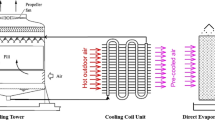Abstract
A novel cogeneration cooler is presented in this paper. The entered air cools in two streams. In the first stream, air goes into the channels and cooling happens without increasing humidity. The second stream is the air flow that goes out of the channels on the water film and cooling happens with increasing of humidity. Both of the two cooled air is useful, but for different places in one building. The film evaporation cogeneration cooler with its’ two new idea can save considerable amount of energy. Production of cooled air with evaporation of water film from surface of aluminum channels and production of humid and non-humid cooled air in this cooler are two helpful ideas that theoretical and experimental calculations approve the practicability of ideas. The results show that this novel cooler has high COP and in the cases that both of its cooled air production can be useful, it has so high performance and can conserve much energy.
Access this chapter
Tax calculation will be finalised at checkout
Purchases are for personal use only
Similar content being viewed by others

References
Tsay YL, Lin TF, Yan WM (1990) Cooling of a falling liquid film through interfacial heat and mass transfer. Int J Multiphase Flow 16(5):853–865
Yan WM, Lin TF (1991) Evaporative cooling of liquid film through interfacial heat and mass transfer in a vertical channel numerical study. Int J Heat Mass Transfer 34:1124–1191
Yan WM (1992) Effects of film evaporation on laminar mixed heat and mass transfer in a vertical channel”. Int J Heat Mass Transfer 12:3419–3429
Agunaoun A, Daif A, Barriol R, Daguenet M (1994) Evaporation en convection force d’un film mince s’écoulant en régime permanent laminaire et sans onde sur une surface plane incline. Int J Heat Mass Transfer 37:2947–2956
Abu-Hijleh BAK, Mousa HA (1997) Water film cooling over the glass cover of a solar still including evaporation effects. Energy 22:43–48
Feddaoui M, Belabmidi E, Mir A, Bendou A (2001) Numerical study of the evaporative cooling liquid film in laminar mixed convection tube flows”. Int J Therm Sci 40:1011–1020
Hongfei Z (2001) Experimental study on an enhanced falling film evaporation air flow absorption and closed circulation solar still. Energy 26:401–412
Author information
Authors and Affiliations
Corresponding author
Editor information
Editors and Affiliations
Nomenclature
Nomenclature
- cp :
-
Specific heat, J kg-1 °C-1
- D:
-
Mass diffusivity, m2 s-1
- g:
-
Gravitational acceleration, m s-2
- h:
-
Heat transfer coefficient, W m-2 °C-1
- k:
-
Conduction coefficient
- l:
-
Length, m
- m:
-
Mass rate, kg s-1
- Mv :
-
Molecular weight, kg mol-1
- Nu:
-
Nusselt Number
- Pv,i :
-
Vapor pressure, Pa
- Q:
-
External heat flux of wetted wall, W m-2
- Re:
-
Reynolds number
- T:
-
Absolute temperature, K
- uG :
-
Axial velocity, m s-1
- vG :
-
Transverse velocity, m s-1
- w:
-
Mass fraction
- λ:
-
Thermal conductivity of the fluid, W m-1 K-1
- μ:
-
Dynamic viscosity of the fluid, kg m-1 s-1
- Cond:
-
Conduction
- Conv:
-
Convection
- f:
-
Surrounding fluid
- G:
-
Gas flow
- L:
-
Water film
- v:
-
Vapor
Rights and permissions
Copyright information
© 2014 Springer International Publishing Switzerland
About this chapter
Cite this chapter
Golchoobian, H., Taheri, M.H., Amidpour, M., Pourali, O. (2014). Theoretical and Experimental Study of a Novel Film Evaporation Cooling System. In: Dincer, I., Midilli, A., Kucuk, H. (eds) Progress in Sustainable Energy Technologies Vol II. Springer, Cham. https://doi.org/10.1007/978-3-319-07977-6_36
Download citation
DOI: https://doi.org/10.1007/978-3-319-07977-6_36
Published:
Publisher Name: Springer, Cham
Print ISBN: 978-3-319-07976-9
Online ISBN: 978-3-319-07977-6
eBook Packages: EnergyEnergy (R0)



